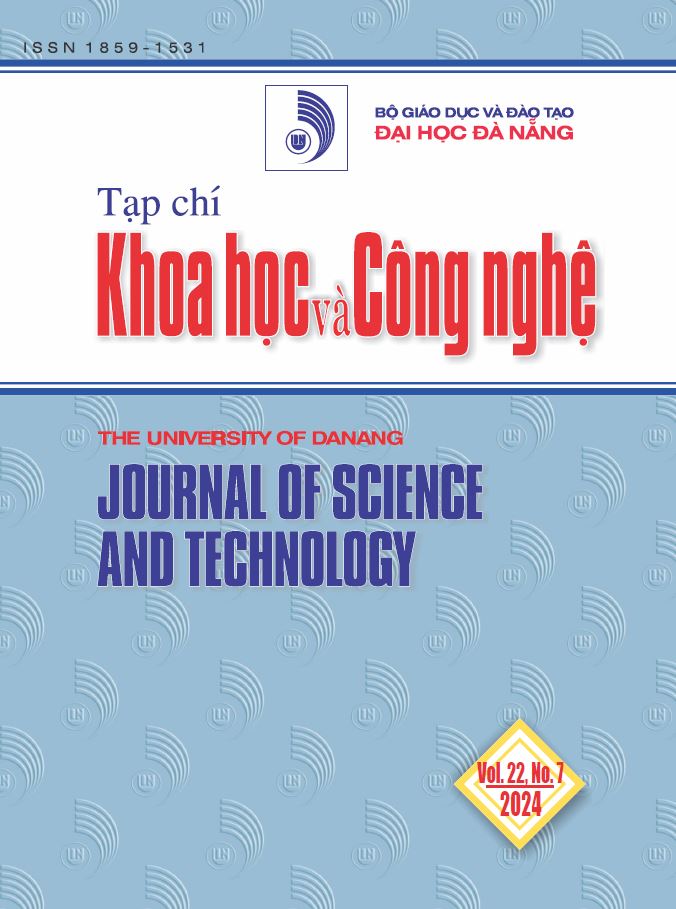Nghiên cứu tác dụng chống oxy hóa và khả năng ức chế enzyme α-glucosidase in vitro của lá Sauropus Androgynus (L.) Merr.
 Tóm tắt: 394
Tóm tắt: 394
 |
|  PDF: 323
PDF: 323 
##plugins.themes.academic_pro.article.main##
Author
-
Đoàn Thị Quỳnh TrâmTrường Đại học Nông Lâm TP. Hồ Chí Minh, Việt NamPhạm Thiết QuốcTrường THPT Hà Huy Tập, tỉnh Gia Lai, Việt Nam
Từ khóa:
Tóm tắt
Một trong những cách giúp giảm lượng hấp thu glucose vào máu trong điều trị bệnh đái tháo đường là ức chế enzyme α-glucosidase. Sauropus androgynus (L.) Merr. chứa nhiều thành phần có hoạt tính sinh học có tiềm năng trong chống oxy hóa và hỗ trợ điều trị bệnh đái tháo đường. Bài báo khảo sát tác dụng chống oxy hóa bằng mô hình khử gốc tự do DPPH và khả năng ức chế enzyme α-glucosidase của lá Sauropus androgynus (L.) Merr. bằng phản ứng phân cắt cơ chất pNG in vitro. Kết quả cho thấy, lá Sauropus androgynus (L.) Merr. có tác dụng chống oxy hóa với EC50>256 mg/mL, so sánh chất chuẩn tham khảo quercetin EC50=9,97 ± 0,25 mg/mL và tác động ức chế α-glucosidase với IC50=10,91 ± 0,21µg/mL so sánh chất chuẩn acarbose IC50=134,56 ± 3,02 µg/mL. Tiềm năng tác dụng oxy hóa và khả năng ức chế enzyme α-glucosidase của Sauropus androgynus (L.) Merr. cần được tiếp tục nghiên cứu ứng dụng trong thực phẩm chức năng và thuốc.
Tài liệu tham khảo
-
[1] V. Duong, D. V. Mai, T. T. Ngon, and M. V. Hung, “Genetic Study of Medicinal Sauropus androgynus (L.) Merr. used in Mekong River, Southern Vietnam”, Pak. J. Biol. Sci., vol. 25, no.5, pp 401-405, 2022.
[2] Roni, T. Sadjimin, M. S. Bani, and Zulaela, “Effectiveness of the Sauropus androgynus (L.) Merr leaf extract in increasing mother’s breast milk production”, Media Litbang Kesehatan, vol. 14, no. 3, pp 20-24, 2004.
[3] Bunawan, S. N. Bunawan, S. N. Baharum, and N. M. Noor, “Sauropus androgynus (L.) Merr. Induced Bronchiolitis Obliterans: From Botanical Studies to Toxicology”, Evidence-Based Complementary and Alternative Medicine, vol. 2015, pp 1-7, 2015. http://dx.doi.org/10.1155/2015/714158
[4] Anju, N. K. S. R. Rai, and A. Kumar, “Sauropus androgynus (L.) Merr.: a multipurpose plant with multiple uses in traditional ethnic culinary and ethnomedicinal preparations”, Journal of Ethnic Foods, vol. 9, no. 10, pp 1-29, 2022. https://doi.org/10.1186/s42779-022-00125-8
[5] N. Yuliani, J. Sambara, S. Poddar, and U. Das, “Formulation and characterization of Sauropus androgynous (L.) Merr. leaf extract Gel in Combination with CMC-Na and Carbopol 940 Using DPPH Method”, Research Journal of Pharmacy and Technology, vol. 15, no. 11, 2022. https://doi.org/10.52711/0974-360X.2022.00878
[6] Fatmawati, E. H. N. Putu , F. Akbar, and P. A. Mustia, “Antioxidant Activity and Sun Protection Factor (SPF) Graded Extract of Katuk Leaves (Sauropus androgynus (L.) Merr.)”, Earth and Environmental Science, vol. 1041, no.1, id.012072, pp 1-9, 2022. https://doi.org/10.1088/1755-1315/1041/1/012072.
[7] Suparmi, M. Fasitasari, M. Martosupono, and J. C. Mangimbulude, “Hypoglycemic and Antianemia Effects of Chlorophyll from Sauropus androgynus (L) Merr. Leaves in Rats”, Pharmacognosy Journal, vol. 13, no. 4,pp 924-932, 2021. https://doi.org/10.5530/pj.2021.13.119
[8] P. E. Hikmawanti, S. Fatmawati, and A. W. Asri, “The Effect of Ethanol Concentrations as The Extraction Solvent on Antioxidant Activity of Katuk (Sauropus androgynus (L.) Merr.) Leaves Extracts”, in IOP Conference Series: Earth and Environmental Science 755, Yogyakarta, Indonesia, 2020, IOP Publishing Ltd, 2021, pp 1-7. https://doi.org/10.1088/1755-1315/755/1/012060
[9] Ekasari et al., “Antimalarial Activity of Extract and Fractions of Sauropus androgynus (L.) Merr”, Scientifica, vol. 2022, Article ID 3552491, pp 1-9, 2022. https://doi.org/10.1155/2022/3552491
[10] Ministry of Health, Decision on the issuance of professional document Guidelines for the diagnosis and treatment of type 2 diabetes mellitus, no.5481/QĐ-BYT, 2020.
[11] K. Patel, R. Kumar, D. Laloo, and S. Hemalatha, “Diabetes mellitus: an overview on its pharmacological aspects and reported medicinal plants having antidiabetic activity”, Asian Pacific Journal of Tropical Biomedicine, vol. 2, no. 5, pp 411-420, 2012.
[12] Singh, R. Kukreti, L. Saso, and S. Kukreti, “Review mechanistic insight into oxidative stress-triggered signaling pathways and type 2 diabetes”, Molecules, vol. 27, no. 950, pp 1-20, 2022. https://doi.org/10.3390/molecules 27030950
[13] Q. Duy, “Evaluation of inhibitory ability of herbs on α-amylase and α-glucosidase for diabetes treatment”, Journal of Vietnam Agricultural Science and Technology, vol. 1, no. 74, pp 76-83, 2017.
[14] T. D. Hanh, P. V. Trung, N. N. Hanh, and N. Đ. Truc, “Investigation on α -glucosidase inhibitory activity of some extracts from the seeds of Momordica charantia L.”, CTU Journal of Science, no. 7, pp 130-137, 2007.
[15] T. Phong et al., “Study on the treatment of hypertension and diabetes of the Phyllanthus acidus”, Vietnam medical journal, vol 529, no. 2, pp 86-89, 2023. https://doi.org/10.51298/vmj.v529i2.6461
[16] B. N. Phuong, D. X. Chu, N. T. N. Van, N. P. Tuan, and N. P. Tu, “Evaluation of inhibitory effects of Azadirachta. sp leaves extraction α-glucosidase activity”, in National biotechnology conference, Hue, Vietnam, 2020, pp 806-814.
[17] M. Thang, N. C. Khan, T. T. Mai, L. T. H. Hao, N. T. H. Ngoc, and T. H. Son, “Determining inhibitory activity of α -amylase and α -glucosidase enzymes of Euphorbia hirta L. extract”, Vietnam journal of nutrition & food, vol. 16, no. 6, pp 99-105, 2020.
[18] Wan, Y. Yu, S. Zhou, W. Liu, S. Tian, and S. Cao, “Antioxidant activity and free radical-scavenging capacity of Gynura divaricata leaf extracts at different temperatures”, Pharmacognosy Magazine, vol. 7, no. 25, pp 40–45, 2011.
[19] Hakamata, M. Kurihara, H. Okuda, T.Nishio, and T. Oku,“Design and Screening Strategies for α-Glucosidase Inhibitors Based on Enzymological Information”, Current topics in medicinal chemistry, vol. 9, no. 1, pp 3-12, 2009. https://doi.org/10.2174/156802609787354306
[20] B.-d. Zhang et al., “Sauropus androgynus L. Merr.-A phytochemical, pharmacological and toxicological review”, Journal of Ethnopharmacology, vol. 257, no. 1, pp 1-13, 2020. https://doi.org/10.1016/j.jep.2020.112778



